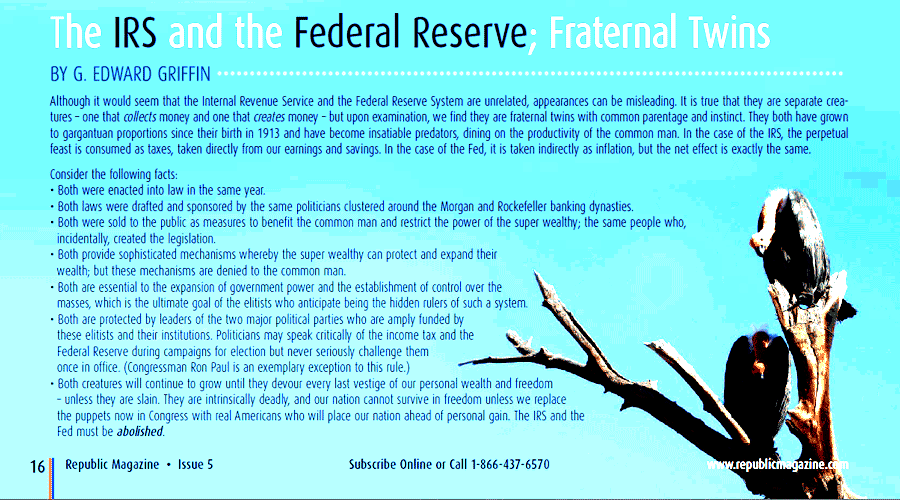seekingalpha | The IRS was Conceived 100 Years Ago Next Month
On
February 3, 1913, Delaware became the 36th state to ratify the proposed
16th Amendment authorizing income taxes. With three-fourths of the 48
states backing the resolution, the 16th Amendment became an official
part of the U.S. Constitution on February 25, while Republican William
Taft was a lame duck President awaiting the inauguration of Democrat
Woodrow Wilson a week later on March 4, 1913.
Six months later,
the Revenue Act of 1913 was signed into law on October 13, 1913
authorizing tax rates ranging up to 7% for those earning $500,000 or
more. The lowest (1%) income tax rate kicked in for single taxpayers
making $3,000 per year or couples making $4,000 or more. Therefore,
fewer than 5% of U.S. workers were obligated to pay any income tax at
first. Businessmen, proud of their success, showed off their tax bill in
bars as if to say "I'm one of the top 5%," a badge of honor in a
capitalist economy.
World War I changed all that. By 1917, President Woodrow Wilson raised the top tax rates tenfold.
In
1916, President Wilson campaigned against joining the "war to end all
wars," but just one month after his second inauguration, he pushed us
into World War I and used the income tax to fund that war effort. In
1917, the top income tax rate grew nearly tenfold, from 7% to 67% on top
income earners. The new income tax tool was powerful enough to fund
America's first entry into a major European conflict.
Unlike most politicians, who tend to mask their views in patriotic
pieties, Wilson clearly stated the pragmatism of his politics much
earlier in his 1889 book The State:
We are not bound to adhere to the doctrines held by the signers of the Declaration of Independence … Government does now whatever experience permits or the times demand.
Wow! Those last 10 words form a chilling expression of raw unprincipled
power. They are also applicable to today's fiscal cliff debate:
"Whatever experience permits or the times demand" is a fair description
of raising tax rates to fund runaway spending needs.
The Federal Reserve was also Born a Century Ago, in 1913
In a parallel track, the Federal Reserve was conceived and born a century ago this year. On March 31, 1913, J.P.
Morgan, America's unofficial one-man central bank, died in his sleep in
Rome. Like any good banking man, he died at the closing day of a
financial quarter handing new President Woodrow Wilson the opening to
create a central bank. After a close call in the Panic of 1907, J.P. Morgan,
then entering his 70s, told the nation he was retiring from the central
banking business, saying that the next panic would sink him - and the
country - even if other syndicate members joined him (as they usually
did).
The death of J.P. Morgan almost nine months later led to the centralized solution everyone seemed to favor then. At 6:02 pm on December 23, 1913, The Federal Reserve Act,
authorizing the creation of the Federal Reserve, was signed into law by
President Woodrow Wilson using four golden pens in a lightly-attended
ceremony during the Christmas break. Like income taxes, the Fed quickly
grew quite powerful.
The Federal Reserve took shape in stages, throughout 1914, with an
official launch date of November 16, 1914. Ironically, the Fed was
formed for the express purpose of avoiding the financial panics so
painful in recent memory - 1893 and 1907 - but the Fed merely continued
the same kind of boom-bust cycle of panics, ranging from a short, sharp
shock in 1920-21, to the long-term Great Depression of 1929 to 1941.
In
particular, the Fed fueled a huge wave of inflation after providing
liquidity for World War I spending. That was followed by a sharp cutoff
in liquidity and a "flash" depression in 1920. The Fed then fueled too
much liquidity throughout the 1920s, leading to a real estate and stock
market crash, followed by a sharp (33%) cut in liquidity between 1929
and 1932. The Fed just couldn't seem to find a balance.
The early Fed was quite clear in its mission. In its 1923 Annual Report, the Federal Reserve described its role clearly:
The Federal Reserve banks are…the source to which the member banks turn when the demands of the business community have outrun their own unaided resources.
This is why the Fed increased credit 61% in the 1920s, from $45.3 billion on June 30, 1921 to over $73 billion in July 1929.
The
Fed's inflationary monetary policies led to a nearly 99% decline in the
purchasing power of the U.S. dollar in gold terms. In 1913, gold traded
for $20.67 per ounce vs. around $1,690 today. Our official cost of
living increase since 1913 is +2,261%, meaning that an item costing $1
in 1913 costs $23.61 now. The Fed's policies have also led to a series
of stock market booms and busts over the century, begging the question
of whether the Fed has been any more effective than J.P. Morgan and his big-banker syndicate.



0 comments:
Post a Comment